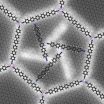Why do people behave badly? Maybe it's just too easy
2010-11-24
(Press-News.org) TORONTO, ON – Many people say they wouldn't cheat on a test, lie on a job application or refuse to help a person in need.
But what if the test answers fell into your lap and cheating didn't require any work on your part? If you didn't have to face the person who needed your help and refuse them? Would that change your behaviour?
New research out of the University of Toronto Scarborough shows it might. In two studies that tested participants' willingness to behave immorally, the UTSC team discovered people will behave badly – if it doesn't involve too much work on their part.
"People are more likely to cheat and make immoral decisions when their transgressions don't involve an explicit action," says Rimma Teper, PhD student and lead author on the study, published online now in Social Psychological and Personality Science. "If they can lie by omission, cheat without doing much legwork, or bypass a person's request for help without expressly denying them, they are much more likely to do so."
In one study, participants took a math test on a computer after being warned there were glitches in the system. One group was told if they pressed the space bar, the answer to the question would appear on the screen. The second group was told if they didn't press the enter key within five seconds of seeing a question, the answer would appear.
"People in the second group – those who didn't have to physically press a button to get the answers – were much more likely to cheat," says Associate Psychology Professor Michael Inzlicht, second author on the study.
In another study, the team asked participants whether they would volunteer to help a student with a learning disability complete a component of the test. One group of participants had only the option of checking a 'yes' or 'no' box that popped up on the computer. The second group of people could follow a link at the bottom of the page to volunteer their help or simply press 'continue' to move on to the next page of their test. Participants were five times more likely to volunteer when they had to expressly pick either 'yes' or 'no.'
"It seems to be more difficult for people to explicitly deny their help, by clicking 'no,' than it is for them to simply click 'continue' and elude doing the right thing. We suspect that emotion plays an important role in driving this effect" says Teper.
"When people are confronted with actively doing the right thing or the wrong thing, there are a lot of emotions involved – such as guilt and shame – that guide them to make the moral choice. When the transgression is more passive, however, we saw more people doing the wrong thing, and we believe this is because the moral emotions in such situations are probably less intense," Teper says.
The team's research on moral behaviour is unique in that it looks at how people behave in certain situations versus simply asking them to predict how they might behave, says Inzlicht. It also has critical implications for those in the business of soliciting peoples' good will, money or time.
"Forcing people to make an active, moral decision – a 'yes' or 'no' to donating, for example – is going to be much more effective than allowing them to passively skip over a request," he says.
INFORMATION:
For more information, please contact:
Rimma Teper
Lead author, PhD student
Cell: 416-648-3843
Rimma.teper@gmail.com
Michael Inzlicht
Assistant Professor, Psychology
Cell: 416-820-2395
Michael.inzlicht@utoronto.ca
UofT Media Relations
416-978-0100
media.relations@utoronto.ca
END
ELSE PRESS RELEASES FROM THIS DATE:
2010-11-24
In the nanoworld many things are different. Scientists only recently started unveiling and harnessing the underlying laws and principles. A team associated with Professor Johannes Barth from the Physics Department of the TU Muenchen have now succeeded in capturing rod-shaped molecules in a two-dimensional network in such a way that they autonomously form small rotors that turn in their honeycomb-like cages.
Nature itself provides the role model for such self-organizing systems. This is how proteins bring reactants so close together that reactions can take place – reactions ...
2010-11-24
CHICAGO (November 23, 2010) - Even though most people are aware that good oral health is essential for the overall health of both mother and child, misunderstandings about the safety of dental care during pregnancy may cause pregnant women to avoid seeing their dentist. The fact is that dentists can create a treatment plan that is safe, effective, and essential for combating the adverse effects of oral disease during pregnancy.
During the course of pregnancy, a woman's oral health can undergo significant changes. According to an article published in the November/December ...
2010-11-24
Even when equipped with compressed-air bottles and diving regulators, humans reach their limits very quickly under water. In contrast, unmanned submarine vehicles that are connected by cable to the control center permit long and deep dives. Today remote-controlled diving robots are used for research, inspection and maintenance work. The possible applications of this technology are limited, however, by the length of the cable and the instinct of the navigator. No wonder that researchers are working on autonomous underwater robots which orient themselves under water and carry ...
2010-11-24
While Africa is certainly no stranger to violence, the response to the Kenyan presidential elections of 2007 came as a surprise. Political unrest evolved into outright and unmitigated violence, marring the relatively peaceful history of Kenya's educated and mainly urban population. During allegations of voter manipulation and election fraud, two of Kenya's largest tribes, the Kalenjin and the Kikuyu, found themselves divided by anger, fueled by another tribe's promises of power and control.
Wesley Shrum, LSU professor of sociology, had experience dealing with human tragedy ...
2010-11-24
AMES, Iowa - Most living plant and animal species have a certain, relatively small, amount of variation in their genetic make-up.
Differences in height, skin and eye color of humans, for example, are very noticeable, but are actually the consequences of very small variations in genetic makeup.
Researchers at Iowa State University, China Agricultural University and the Beijing Genomics Institute in China recently re-sequenced and compared six elite inbred corn (maize) lines, including the parents of the most productive commercial hybrids in China.
When comparing the different ...
2010-11-24
Tel Aviv -- Ferrography, a practice used by the American and Israeli air forces to monitor the condition of machinery, extracts tiny iron particles from lubricants such as oil and grease to analyze wear in machines. Determining whether a system requires preventative maintenance can be the key to preventing catastrophic failure.
Now Tel Aviv University scientists are exploring a modification of this technique for human analysis -- called "bio-ferrography" -- to diagnose diseases in their early stages, determine the efficacy of drugs, and ascertain the condition of orthopedic ...
2010-11-24
Lions, bears, monkeys, crocodiles, parrots and iguanas may seem inoffensive at first glance when they're behind bars in zoos. But some exotic species can escape and become invasive species. This has been confirmed by a scientific team that has checked 1,568 animal houses in 63 Spanish zoos. Birds are the animals most likely to escape.
"As zoos house a large number of exotic (non-indigenous) species, they could become an entry channel for these species if they escape, with the potential environmental risk that this implies", María C. Fàbregas, lead author of the study ...
2010-11-24
(Boston) – Researchers from the Boston University School of Medicine (BUSM) have demonstrated that commensal species of the genus Neisseriae are low inducers of human airway epithelial cell responses as compared to the pathogenic species. Specifically, the study indicates that a Neisserial outer membrane component appears to play a differential role in the host inflammatory responses via interaction with a receptor on the surface of human airway epithelial cells.
Paola Massari, an assistant professor in the section of infectious diseases at BUSM, is lead author of this ...
2010-11-24
The venus flytrap plant captures its prey when it senses the presence of an insect on the tips of its leaves. An amphiphilic molecule designed by chemists at The City College of New York acts in a similar manner by changing its structure when heated slightly and, then, reverting to its original form when cooled.
The finding, reported in the journal Angewandte Chemie, points toward the possibility of designing adaptive soft materials in the lab that take their cues from how nature responds to stimuli, said Dr. George John, associate professor and corresponding author.
Professor ...
2010-11-24
In a cross-sectional study from the 2004 and 2007 Australian National Drug Strategy Household (NDSH) surveys, respondents were questioned about their current and past drinking, the presence of formal diagnosis for specific diseases (heart disease, type 2 diabetes, hypertension, cancer, anxiety, depression) and self-perceived general health status. The sample sizes for the 2004 and 2007 NDSH surveys were 24,109 and 23,356, respectively.
The authors report that respondents with a diagnosis of diabetes, hypertension, or anxiety were more likely to have reduced or stopped ...
LAST 30 PRESS RELEASES:
[Press-News.org] Why do people behave badly? Maybe it's just too easy




